Lathe cutting tools are tools you can use with a lathe machine to produce turned parts and shape materials into the desired shape. They are an important part of CNC machining. However, much knowledge on using them is not available about them since there are many types of cutting tools.
Thus, this article will dwell extensively on different types of lathe tools seen in CNC turning. And you can also know how to choose the right types of cutting tools and what a lathe is and the different lathe cutting operations from this guide. Let us dive right in.
What is a Lathe Machine?
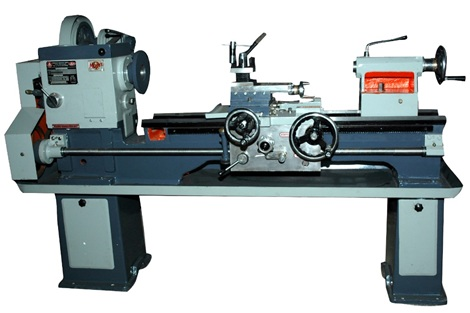
A lathe is a machining tool that can rotate metal or wood to the desired shape. It uses stationary lathe cutting tools to perform several operations, such as turning, undercutting, knurling, drilling, facing, boring, and cutting. And the lathe machine is often used to remove the excess material from the workpiece to achieve a specified size and shape of the workpiece.
Common Lathe Cutting Tool Operations
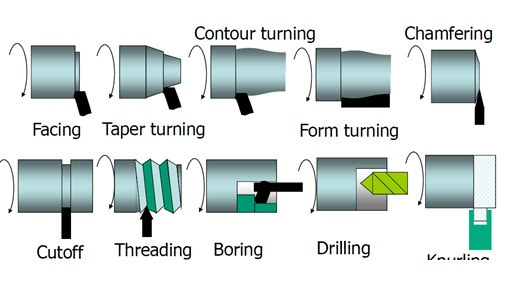
Depending on the lathe machine, there are different lathe cutting operations you can undergo to get your desired shape. Below is a short explanation of your common operations in your CNC machining project.
Facing
Facing is the first step in most lathe operations. It involves cutting the metal from an end to make it fit at the right angle of the axis.
Tapering
Tapering involves cutting metal to a cone shape using a compound slide. Depending on the requirement, you can also change the angle by adjusting the compound slide.
Parallel Turning
Parallel turning involves cutting a material parallel to the axis. It is an important operation used for decreasing the diameter of the material.
Parting
Parting is the removal of a part so that it faces the end. It involves using a parting tool which we will introduce later. You can make the cut deeper by pulling out the parting tool and transferring it to the side of the cut.
Classifications of Lathe Cutting Tools
There are three major classification categories for lathe cutting tools: material, uses, and feed application method. Below is a detailed introduction to the three different classifications and common types of cutting tools.
Classification by Material
High-speed steel tool
As its name sounds, the lathe machine tool is made of high-speed steel (HSS), which can maintain hardness although it is put in a service temperature of up to 1000° F. (588° C.). Therefore, they are ideal for rough machining and semi-finish machining.
Carbide tool
The cutting edge of the carbide tool comes from carbide. Therefore, they are ideal for cutting iron, plastic, glass, stone, steel, and other difficult materials.
Diamond Blade
Diamond is a very hard and wear-resistant material. It has a low coefficient of friction, high elastic modulus, high thermal conductivity, and low thermal expansion coefficient. Consequently, the lathe tools with diamond cutting edge are ideal for precision machining of brittle, wear-resistant, conforming, and hard materials such as graphite.
Other Materials
The cutting edge of these types of machine lathe tools comes from other materials such as cubic boron nitride and ceramic. Therefore, they are ideal for rough machining and cutting hard alloys.
Classification of Lathe Cutting Tools by Use
Turning Tool
There are two general types of turning cutting tools in terms of their uses: rough turning tools and finish turning tools.
Rough turning tools
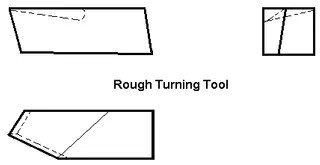
Rough turning tools are used for removing large parts of a workpiece in a very short time. They have a ground cutting angle that allows the removal and they can withstand maximum cutting pressure.
Finish turning tools
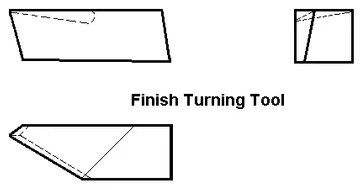
Finish turning tools are the types of lathe machine tools used for removing small parts of the workpiece. The angle is ground and according to its name, the end product has a smooth and accurate surface.
Boring Tool

A boring is a type of lathe tool used for enlarging a hole. These turning tools are inserted into a pre-existing hole and used to widen the hole’s diameter.
Chamfering Tool
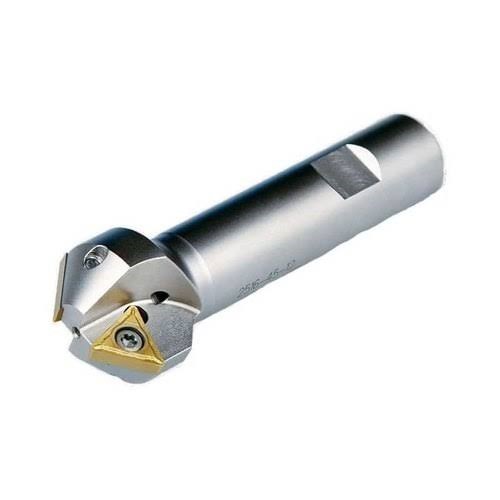
Chamfering tools are lathe turning cutting tools used for creating a furrow on a part. It can also be used to create smooth or hazardous edges on a workpiece.
Knurling Tool
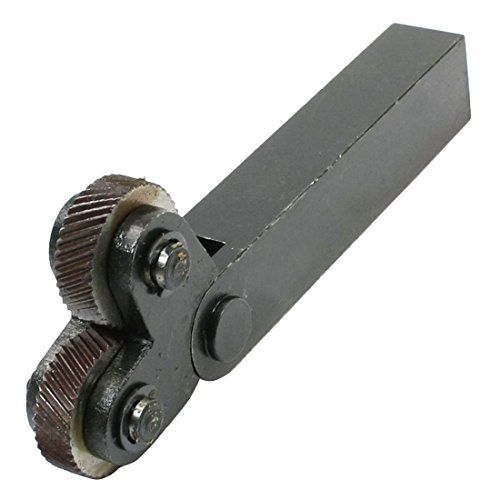
Knurling tools are a type of lathe tool that can produce knurled lathe parts by creating a specific pattern into a round section. Therefore, You can use them as a grip for handles or fasteners like nuts.
Parting Tool
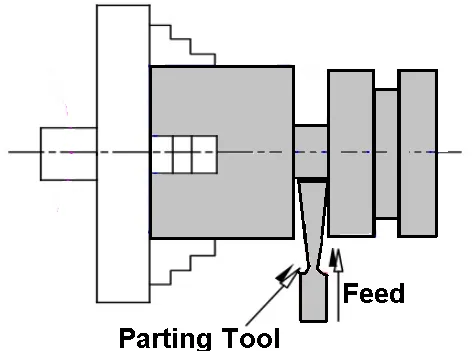
A parting tool is a narrow-bladed tool used for cutting off pieces of materials from a workpiece. It has many forms and uses with popular use indicating it functions as a turning tool and cutting tool.
Thread Cutting Tool
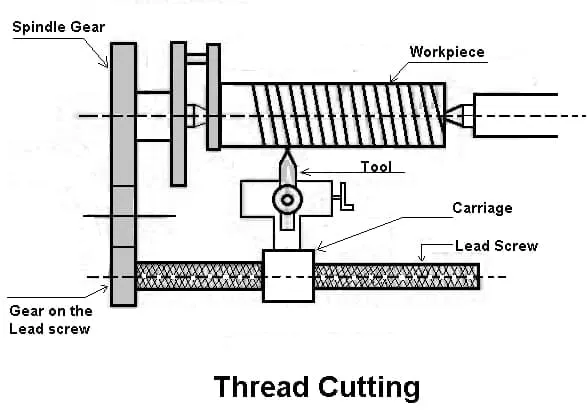
Thread-cutting tools are applicable in cutting threads on a lathe part. There are two general forms: internal and external thread cutting. External thread cutting involves the workpiece being held in a chuck or mounted between two centers. However, in internal thread cutting, the part is held in a chuck while the tool moves across it in a linear format taking chips off the workpiece as it passes it.
Facing Tool
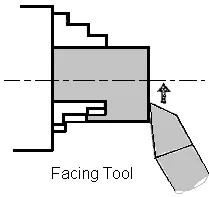
A facing tool is a type of lathe machine tool used to cut a flat surface that is perpendicular to a workpiece’s rotational axis. The tool holder situated on the lathe carriage holds the tool during the process so that it can feed perpendicularly across the rotational axis of the part.
Classification of Lathe Cutting Tools by Method of Applying Feed
Right-Hand Tool
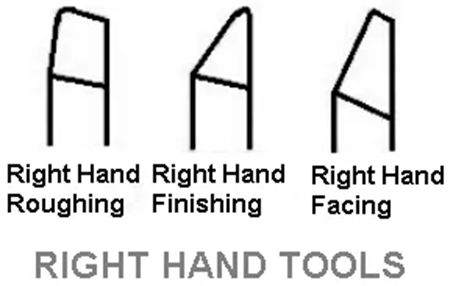
A right-hand tool removes material when moving from right to left (it takes only the top view keeping the rake surface at the top). The name right-hand tool was used based on the human hand analogy. Using the right human hand, the thumb represents the tool feed direction. Therefore, the principal cutting edge of the tool is on the tool’s left side.
Left-Hand Tool
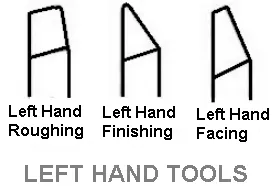
Unlike a right-hand tool, the left-hand cutting tool removes material when moving from left to right (top view keeping rake surface visible). Using the left human hand, the thumb represents the tool feed direction. Therefore, the principal cutting edge of the tool is on the tool’s right side.
Round Nose Tool
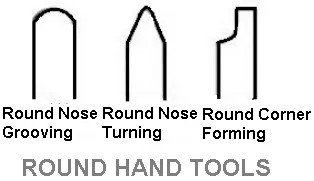
A round nose turning tool has no back rake or side rake. Therefore, the tool is fed from the left to the right or from the right to the left-hand end of the lathe bed away. However, in some cases, the round-nose tool can have a small back rake. Due to the rounded edge, round nose turning tools are popular tools in finish turning operation.
How to Select Lathe Machine Tools
Selecting a lathe cutting tool comes with understanding certain factors about the equipment, and below are very important factors you must consider.
Type of Materials
The type of CNC material you are cutting is one of the important factors as it determines the type of lathe tools you can use. Important properties that you must look out for before selecting a lathe machine tool include: hardness, wear resistance, toughness, and rigidity. These properties can determine the type of cutting tool used in lathe machines. For example, extremely hard materials need carbide tools or diamond tools.
The Shape of the tool
The shape of the tool is also another factor to consider during selection. The location of the cutting edge also determines the direction in which the tool will cut (right-hand tools, left-hand tools, and round nose tools).
The Desired Shape
All types of lathe tools listed under the classification by use can lead to a specified shape. Therefore, you have to integrate the desired shape to the required lathe machine tools. Due to the complexity of most CNC machining products, you might need to choose several cutting tools.
Selecting the right types of tools used in lathe machines might be a little problematic if you are new to CNC turning processes. However, instead of worrying about how much you have to know, why not engage the services of professionals in such an area. At KevoRapid, we have engineers with years of experience in CNC machining with an understanding of different types of lathe cutting tools and their applications. By choosing us, you get access to years of experience and an attitude toward quality delivery. Just get in touch with us. We’re at your service!
Conclusion
Lathe cutting tools are an important part of any CNC machining or CNC turning operation. However, there are many types of cutting tools in lathe machines available with no distinct disparity to many engineers. To simplify it, this article has showcased the different classifications of lathe tools and how to select one. If you are still not sure which type of lathe machine tools can lead to your desired shape, you can upload your CAD file to get professional suggestions from our expert team, or contact us by email info@kevorapid.com now.
FAQs
What are cutting tools used for?
Cutting tools also knowns as cutters are tools used for removing parts of a workpiece. They are mounted on a lathe which is a machine used to turn materials and shape them to the desired shapes. Examples of cutting tools are boring tools, chamfering tools, etc.
What are the types of lathe cutting tools?
The lathe machine tools can be classified into different categories. The most common classifications include:
Use: turning tool, boring tool, chamfering tool, grooving tool, etc.
Material: high-speed steel tool, carbide tool, diamond blade, other materials, etc.
Method of applying feed: right-hand tool, left-hand tool, round hose tool.